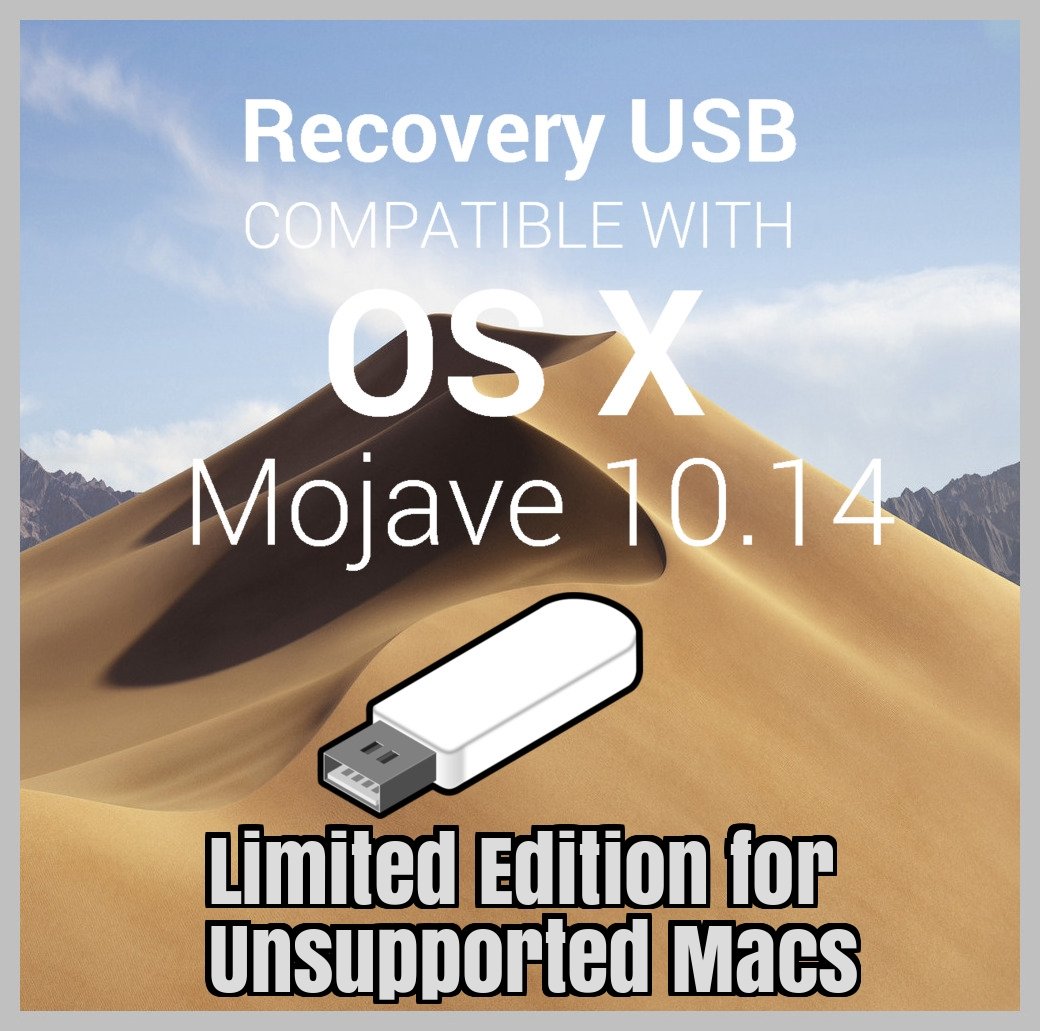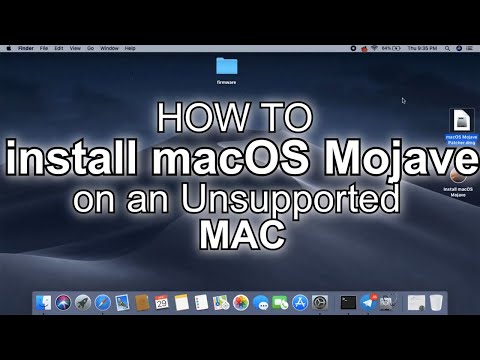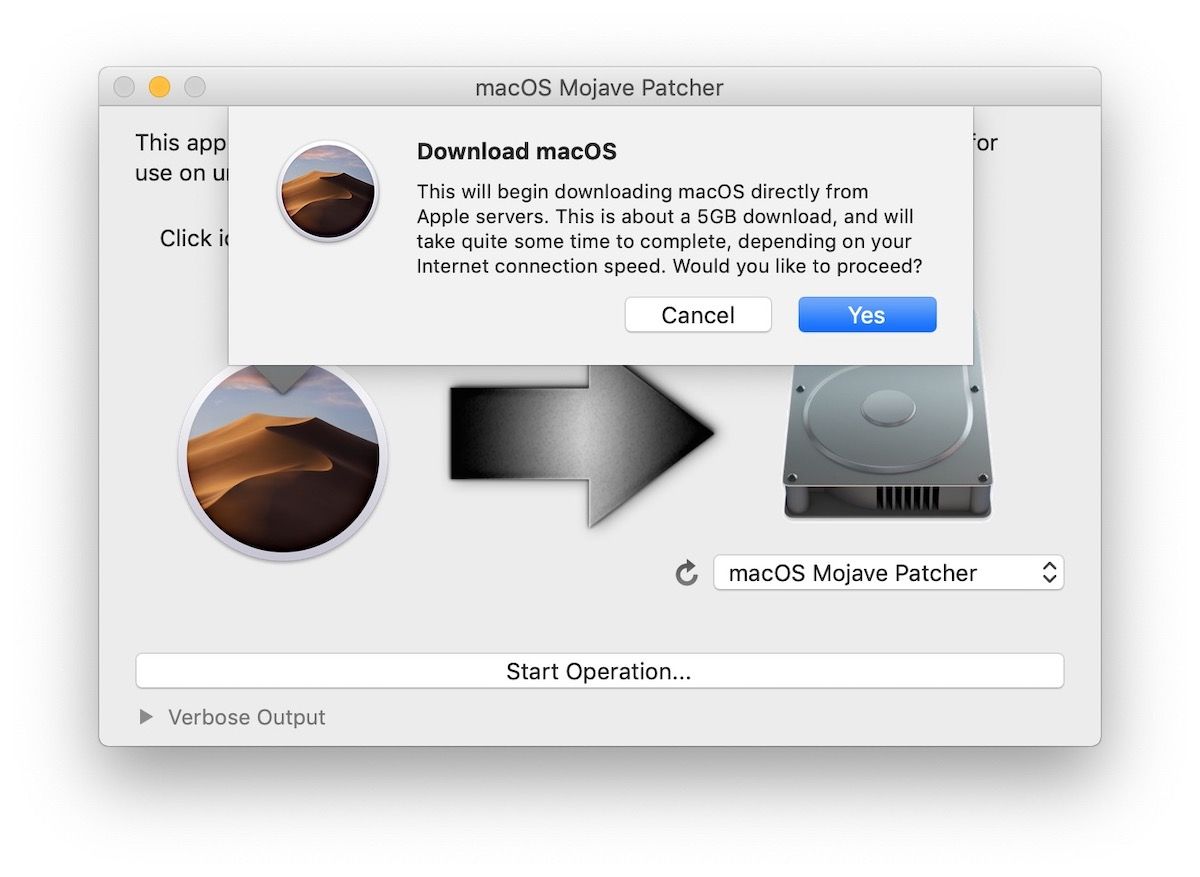Macos Mojave For Unsupported Macs
Macos Mojave Performance On Older Macs Install Macos Mojave On Unsupported Mac Allow the installation to proceed and the relevant patches will be applied to your unsupported Mac automatically. Apple could always release a future update to macOS 10.15 that prevents the. Install macOS Mojave on unsupported Mac Before going to upgrade there are two important points that you should know about that, the first one checks your Wifi compatibility, because some of Mac have Wifi which is unsupported in the macOS Mojave. And the second one is you need to disable the ACP before installing the macOS Mojave. Aug 03, 2021 That is install macOS Mojave on Windows. How to keep older Macs secure: a geeky approach (run Catalina on unsupported Macs) Posted on October 8th, 2019 by Jay Vrijenhoek. Note: This article was originally written for macOS Mojave, and has been adapted for macOS Catalina. From a security standpoint, using the latest version of macOS—the Mac.
- Macos Mojave For Unsupported Macs
- Macos Mojave For Unsupported Macs Version
- Macos Mojave For Unsupported Macs Free
- Macos Mojave Download Unsupported Mac
- Macos Mojave Patcher Tool For Unsupported Macs
Comments
- pls direct me to the right forum is the following question is not to be posted here.I downloaded the patch version dosdude1 Current version: 1.1.2.Created the flash drive and got a successful complete.Tested on a Macbook Pro mid 2011 and a new hard disk.The installation bar goes to the end and stays there, waited for a long time and have to shutdown the computer.I used Mojave Beta2 and i don't know if this is the problem. the dosdude1 version suggest the latest.So what Mojave beta works with Dosdude1 current version: 1.1.2?anybodyP.S. I know there some old version of this tool, which one will work?
- I have a 2011 iMac, cant i just upgrade the chip, ram and graphics card to make it work?
Not Happy, I have a iMac 27p SSD I7 mi-2009 fast, and NO MOJAVE UPGRADE, disgusting, Authorize only Mac's after 2012, that is 6 years old, use not acceptable when you think that your machine costs 4000 dollars, even Microsoft does not do that
A Mac is not a Phone !
I can understand that some features cannot be available, but the FULL release not available without a good technical cause cannot be accepted without fight.
Is there an association there that could issue a class action to claim for Mojave support for our not so old Macs ?
I have a 2009 PC with the latest Windows 10, Is not Apple ashamed to issue a Mojave is forbidden to a perfectly fast and modern machine like the iMac mid-2009 ? Same for MacBook Pro ? same for MacBook Air ? Please Steve come and clean their minds.
We have to make the buzz on Social Networks and Mac information sites, If not the delay will be 5 years, then 3 years, then 1 year and we will have to go back to Windows PC.
Best Regards
Not Happy, I have a iMac 27p SSD I7 mi-2009 fast, and NO MOJAVE UPGRADE, disgusting
Last it seems that there was a deal with Microsoft to use a microsoft antialiasing software up to 2017, this would restrict Apple Mac OS to Retina display, may be this is the real reason for discarding more that 5 years old Macs that are not Retina, a number of users having non retina screens (external ),are claiming that fonts are ugly with Mojave !!
So do not upgrade to MOJAVE if you have non Retina external display, try it with a Dongle.
- That is correct, and is exactly what I do, OutdoorAppDeveloper I would like to add a question. What if you upgraded the RAM and switched from an HDD to an SSD, would it be ok to install Mojave on a 2009 Mac with all of these upgrades?
- I did this but now the MBP (early 2011) start complaining about hardware accelaration not turned on. Any ideas?
- I have an iMac mid 2011 and I really intend to buy a new one. But for now all I can do is update it to Mojave and upgrade my actual RAM and change disk to SSD.
- I attempted using macOS Mojave Patcher v1.2.2, downloaded Mojave as instructed, created the USB installer however after rebooting the USB installer could not be seen. There’s no way to boot from it at all, any ideas?edited January 2019
- There's a compelling reason for installing Mojave on my mid-2009 MacBook Pro: Adobe Creative Cloud 2019 will not install on any older versions of MacOS. DosDude's patcher worked flawlessly, and the only problem with the update is cosmetic; the menu bar has a grey tint. I was able to install CC 2019 and it works perfectly.
You can disable transparency and then it'll work normally.There's a compelling reason for installing Mojave on my mid-2009 MacBook Pro: Adobe Creative Cloud 2019 will not install on any older versions of MacOS. DosDude's patcher worked flawlessly, and the only problem with the update is cosmetic; the menu bar has a grey tint. I was able to install CC 2019 and it works perfectly.
system preferences>accessibility>Display> enabling 'reduce transparency' removes the 'greying out glitches in light mode.- Posts: 2unconfirmed, memberHello!!! I'm in desperate need of some help. I tried following the provided in the mojave tool however I after step 6 my mac shut down and when I turn it on it has a cancel sign 🚫
I'm wondering if anyone can help me at least get it back to how it was before?
Thank you! - Posts: 2unconfirmed, member
I tried to add an emoji of the cancel sign but it didn't work so I'll add a picture of what it looks like here: - Though I used a different method and it worked like a charm. The methods can be found here- https://techrechard.com/how-to-install-macos-catalina-on-unsupported-mac/
In October last year, Apple releases a new version of macOS dubbed as ‘Catalina.’ This latest installment of macOS includes new features, including new apps for podcasts, music, and TV (replacing iTunes), the ability to use iPad as an external monitor, a revamped Photos app, and many more. Seeing this, it’s no wonder that some Mac users want to update their OS version to Catalina. However, not all of them have the luxury to do so.
Officially, macOS Catalina won’t work on older Mac devices that are deemed not powerful enough, according to Apple. Additionally, they provided the official list of the supported Macs:
- MacBook models released in 2015 or after
- MacBook Air models released in mid-2012 or after
- MacBook Pro models released in mid-2012 or after
- Mac mini models released in late 2012 or after
- iMac models released in late 2012 or after
- iMac Pro released in 2017
- Mac Pro models from late 2013
The procedure below will allow Macs or Hacks able to install High Sierra to also install Catalina or Mojave (eg SMBIOS MacPro5,1, iMac11,3, MacBook Pro7,1 which have been unsupported in macOS 10.14.x and 10.15beta) -credit to @ASentientBot's post. Mac or Hack capable of and running High Sierra 10.13.x 2. The Mojave 10.14.1 update does NOT install properly on unsupported machines, and could result in an unbootable OS. If you want to install the 10.14.1 update (and are not currently running 10.14.1), perform the following steps:. Download the latest version of Mojave Patcher. Download the installer using the Tools menu of Mojave Patcher.
This means that if you have a Macbook Air or iMac released in 2011, you won’t be able to upgrade your OS to Catalina. What version of macOS do you have? Adobe flash player for mac os x latest version.
If you’re unsure what version of macOS you have, you can check your macOS or OS X version by clicking the Apple icon at the top-left corner of Mac’s screen, then select About This Mac. In the Overview tab, look at the Mac model year below the OS version number. If the year is the same or above the previous compatibility list, then you should be able to install macOS Catalina formally. If not, read on.
Make your old Mac support macOS Catalina
Older Mac owners don’t have to worry. It’s not the end of the world. There’s a patch that lets you install Catalina to Macs that are not officially supported.
The patch is known as DosDude Catalina Patcher. DosDude Catalina Patcher is a third-party tool, meaning Apple does not develop the tool. It’s made by an individual developer instead. Keep in mind that just because you can make your old Mac run Catalina, it doesn’t necessarily mean it will always be a good thing to do.
Apple prevents older devices to run Catalina for a reason. As mentioned before, anything older than the officially supported hardware will most likely offer suboptimal performance using Catalina, not to mention that some features need newer hardware to function properly.
Despite that, it doesn’t mean that all old machines won’t run macOS Catalina well. Given that your hardware is capable enough, running Catalina shouldn’t introduce any lasting problems. The macOS Catalina Patcher is also updated regularly to address any issues that may surface. Otherwise, you can always downgrade your macOS to an older version if needed.
Install macOS Catalina on an older Mac
Before we begin, it might be a good idea to have a backup of your system using Time Machine, just in case. Creating a backup is always recommended. It’s not only useful for installing a new OS version can enable you to undo any changes after an update, which would be very helpful should something go wrong.
Once you are ready to jump into upgrading, follow the step-by-step guide below to install macOS Catalina on an older Mac using DosDude Catalina Patcher.
- First off, download the most recent version of Catalina Patcher from the official website.
- After the app is downloaded and installed, open it.
- The app will present you with a welcoming message. Keep clicking Continue until it finishes.
- Afterward, you need to get the macOS Installer App from Apple. You can either Download a Copy or Browse for a Copy… if you already have one. If you choose to download, the file size is about 7 to 8 GB, so you may need to wait for a while.
- Plug in a USB flash drive to your Mac and select Create a bootable installer on the Installation Method section.
- On the next screen, your flash drive should be detected as a volume. Else, you may have to first format your USB drive into macOS Extended Journaled if you haven’t already.
- When the flash drive is detected, select it, and click Start.
- Once the bootable installer is copied into the USB drive, restart your Mac. Hold down the Option key while the rebooting process takes place to open up the Startup Manager.
- From the boot list, choose the USB flash drive installer.
- Then, you’ll be taken to the macOS Utilities window. One thing to note is that if you run a version of macOS that is earlier than High Sierra, you’ll need to reformat your installation hard drive to APFS before proceeding. Use the Disk Utility option from the available list on the macOS Utilities window to do so. Otherwise, skip to the next step.
- Click on Reinstall macOS to install Catalina. Simply follow the process until the new OS, and the relevant patches are installed successfully.
Now, you can enjoy the latest version of macOS on an older Mac. Remember that Apple doesn’t recommend you do this, so some troubles might show up when operating your device. Even though dosdude1, the developer of Catalina Patcher, introduces new patches regularly, it shouldn’t be surprising if the experience may not be as good as using Catalina on Macs that officially supports it.
How to Install MacOS Mojave on Unsupported Macs with DosDude Mojave Patcher

https://ift.tt/2zAfYdb
Mac Os Mojave Patch Tool For Unsupported Macs Files
As you may know by now, the list of MacOS Mojave compatible Macs is more strict than previous releases of Mac OS system software, but that doesn’t necessarily mean you can’t install and run macOS Mojave on some unsupported Macs. If you’re an advanced Mac user and you’re reasonably brave (and have adequate backups), then it turns out you might be able to install and run MacOS Mojave on unsupported Mac hardware after all, thanks to a free third party tool from the technical wizard known as “DosDude”.
Essentially the Mojave Patcher Tool creates a modified USB installer drive (similar to the regular Mojave boot installer drive you can make) which you can then use to install not only macOS Mojave on the otherwise unsupported Macs listed below, but also a series of patched macOS Mojave component files that allow it to boot.
Just a quick word of caution: while you may be able to get macOS Mojave running on an unsupported Mac, this is truly only for advanced users who are adventurous. You certainly wouldn’t want to try this on a Mac that you must have performing in an optimal setting at all times, or on your only computer, but if you feel like tinkering around and running macOS Mojave on an unsupported Macintosh computer you can certainly try it out. Because it patches the operating system and installer, not everything is going to work perfectly on all machines – for example, on some machines networking may not work, or an iSight camera may not work, or GPU acceleration may not function – and there could be various bugs, performance quirks, and other theoretical problems with attempting this, but for the truly tech savvy and brave, the Mojave patcher tool and accompanying walkthrough from DosDude can get the job done.
The DosDude website has both a complete tutorial available at the above link, along with the downloadable patcher tool.
Dosdude also produced a YouTube video demonstrating macOS Mojave on a technically unsupported older MacBook Pro 17″ model from 2009, and Mojave actually appears to run pretty well on the machine:
Thanks to the Dosdude website for the screenshot above of the “About This Mac” screen, which is showing Mojave on an older unsupported Mac.
So while the official list of supported Macs for macOS Mojave is pretty strict in comparison, and you can’t just download Mojave and install it on unsupported hardware without the DosDude utility, the unofficial list of Macs that can run the OS through the tool is much more generous as you can see below, with many perfectly good Macs making the cut.
List of Unsupported Macs That Can Run MacOS Mojave with DosDude Mojave Patcher
Unsupported Macs that apparently can use the Mojave patcher to install macOS Mojave include the following:
– Early-2008 or newer Mac Pro, iMac, or MacBook Pro:
– MacPro3,1
– MacPro4,1
– iMac8,1
– iMac9,1
– iMac10,x
– iMac11,x
– iMac12,x
– MacBookPro4,1
– MacBookPro5,x
– MacBookPro6,x
– MacBookPro7,1
– MacBookPro8,x
– Late-2008 or newer MacBook Air or Aluminum Unibody MacBook:
– MacBookAir2,1
– MacBookAir3,x
– MacBookAir4,x
– MacBook5,1
– Early-2009 or newer Mac Mini or white MacBook:
– Macmini3,1
– Macmini4,1
– Macmini5,x
– MacBook5,2
– MacBook6,1
– MacBook7,1
Macos Mojave For Unsupported Macs


– Early-2008 or newer Xserve:
– Xserve2,1
– Xserve3,1
As you can see, the potential list of Macs that can run Mojave with the assistance of this process is much more thorough than what Apple officially supports. But caveat emptor, as with all software modifications.
Will everything be perfect? Certainly not. Will performance be better than some other versions of Mac OS or Mac OS X? Probably not, it might even be worse. Will everything work exactly as expected, as if it was an official support from Apple? No, probably not. But that doesn’t mean that it’s not worth pursuing for some Mac users, and perhaps the better features in macOS Mojave are too compelling to not try out by venturing into the waters of
If this sounds appealing to you, then check out the Dosdude tutorial and Mojave patch tool. Just remember this is NOT an official patch or release from Apple, and due to the technical nature of this it isn’t for the faint of heart, you will absolutely need above average technical knowledge, patience, and full backups of the computer, as this is basically a hack that allows Mojave to install and run on hardware that Apple does not support.
There’s obviously no tutorial included here in this post as I haven’t personally tried or tested this yet, but if you do, and you get macOS Mojave running on an older Mac, be sure to let us know in the comments below how well it works, and what your experience was. Personally, my older unsupported Macs are still running Snow Leopard, Mavericks, El Capitan, and Sierra, and only the latest machines will run Mojave for my particular setup, but to each their own, and it’s undoubtedly cool that Dosdude has consistently come up with utilities like this to get various versions of Mac OS system software running on hardware that it wasn’t specifically intended for. It’s your Mac so use it however you like and with whatever operating system software release you like best. Enjoy!
Related
Macos Mojave For Unsupported Macs Version
AppleMacos Mojave Patcher Tool For Unsupported Macs
Macos Mojave For Unsupported Macs Free
via OS X Daily http://osxdaily.com
Macos Mojave Download Unsupported Mac
